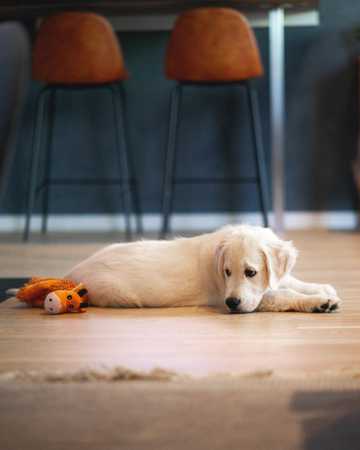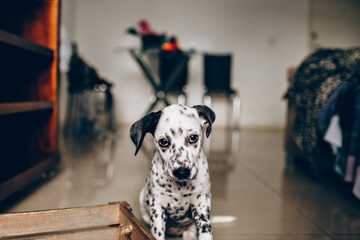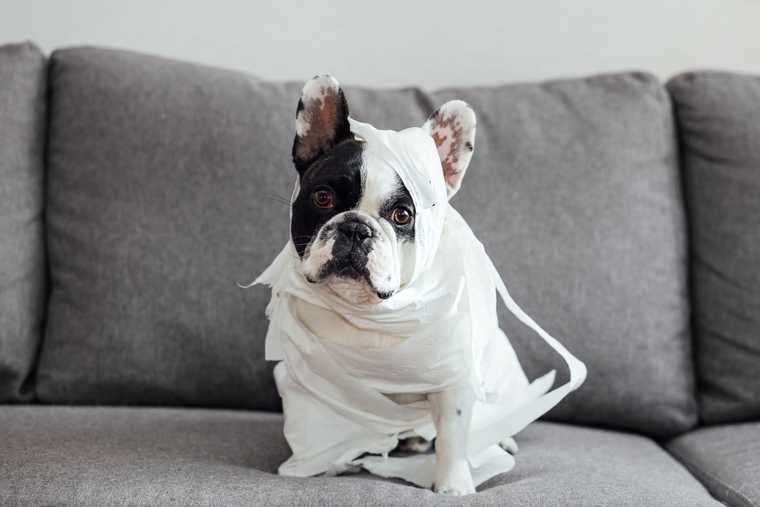Leaving Dogs Home Alone: All the Dos and Don’ts

Leaving our furry pals home alone is just a part of being a pet parent. Whether it's a short trip to the store or a longer workday, knowing how to handle this situation can make a big difference in your dog's happiness and your own peace of mind.
In this guide, we'll walk you through all the dos and don'ts of leaving your dog home alone and share some helpful tips to ensure your four-legged friend stays safe, happy, and well-adjusted when you're not around.
Below, you’ll find a table showing you age-based timing for leaving a dog home alone:
| Dog’s age | Time alone |
|---|---|
| Puppies under 10 weeks | 1 hour |
| Puppies of 10-12 weeks | 2 hours |
| 3 months | 3 hours |
| 4 months | 4 hours |
| 5 months | 5 hours |
| 6 months | 6 hours |
| 6 - 18 months | 4-6 hours |
| Adult dog (18 months - 7 years) | 6-8 hours |
| Elderly dog | 2-6 hours |
While this table likely provides estimates for how long puppies and dogs can hold their bladder, the specific duration a dog can be left alone at home truly depends on the individual dog.
When leaving your pup at home, you should also consider their breed, as this can influence their personality, temperament, and their tolerance for being alone. For instance, Border Collies and Australian Shepherds are known for their high intelligence and energy levels. These dogs may become restless or even engage in destructive behavior if they don't get enough mental stimulation and physical exercise.
On the other hand, more independent and less active breeds, such as Basset Hounds and Shih Tzus, might be more comfortable with longer periods of solitude. However, these breeds can develop separation anxiety if left alone for too long.
Toy breeds like Chihuahuas and Yorkshire Terriers are very owner-oriented, and considering that people often treat them like real babies, they’re more likely to develop a phobia of being left alone, i.e., separation anxiety. That is why teaching these dogs to be more independent and confident is crucial.
Top Tips Before Leaving Your Dog Home Alone

Dogs are social creatures. What’s more, they consider us part of their pack and don’t really understand why we need to leave them alone from time to time. Our task here, as their caring parents, is to teach them to like being home alone and prevent poor behaviors as a result.
If you’ve just got a new puppy or adopted a dog from a shelter, they might need a similar guide on getting used to staying home alone:
-
Puppy-proof your house: Make your living space safe and secure for a new puppy or a rescue pooch by removing potential hazards and limiting their access to dangerous or valuable items. This typically involves securing electrical cords, toxic substances, and small objects and providing a safe confinement area if necessary to prevent potential accidents and injuries.
-
Crate-train your dog: Crate training is essential to help your dog settle down and establish their own safe zone. Not to mention, it helps prevent undesirable behaviors. You can find a comprehensive crate training guide in the Woofz app.
-
Learn their routine: Learning your dog's routine is essential as it helps you meet their needs effectively, manage their behavior, and prevent anxiety. It ensures you're on top of their bathroom breaks, meals, exercise, and playtime, promoting their well-being.
-
Teach them to like being home alone: Introduce short absences (start with 30 seconds and slowly increase the time) when they’re in a crate or in a small room, and make sure they always have something fun to do. Get more tips in the Woofz app.
-
Provide enrichment: Mental stimulation is vital to keep your dog’s mind active, prevent boredom, and support their overall cognitive health. Furthermore, dogs that always have something to do when alone are less likely to react badly to being separated from you.
-
Make sure they’ve got enough activities when with you: When dogs are mentally and physically tired from activities and playtime, they’re more likely to relax and rest when you’re gone, making the transition to being alone less stressful.
-
Don’t make a big deal out of leaving and returning: When you fuss over your coming and going, your dog will get more and more excited, potentially making your absence more stressful for them. By maintaining a low-key approach, you help your dog see your comings and goings as routine, reducing their anxiety.
Now, if you have a grown-up dog that has a clear problem with staying home alone (vocalizing, destroying furniture, trying to break free, etc.), you might be dealing with: separation anxiety, dislike of being home alone, or boundary frustration. To truly help your dog, you need, first, to understand what the real issue is and, secondly, how to properly treat it.
Separation Anxiety or Dislike of Being Home Alone?
There’s a common misconception that the only reason dogs have problems staying home alone is separation anxiety. However, the reasons may vary, and it’s important to understand your dog’s own case.
Separation anxiety
Separation anxiety is a behavioral panic disorder or a phobia of being left alone and separated from the primary caregiver(s).
Below, you will find the symptoms of SA:
- Vocalization (barking, whining, howling)
- Pacing
- Panting
- Scratching at the door
- Urinating/defecating
- Destructive behavior
Usually, the dog starts panicking even before the person leaves, e.g., the trigger is putting on a coat or your shoes! However, this may not be the case for a puppy as they’re less familiar with these leaving cues.
How to deal with separation anxiety?
The only way to treat it is through gradual desensitization to leaving cues and absences. Begin by taking note of your pre-departure routine. Next, experiment with each of these actions individually to pinpoint which triggers your dog's restlessness or which makes them more alert. Once you’ve identified which of your behaviors provoke a reaction, we can call these the “leaving cues.”
Next, follow the steps below:

Step 1.
Choose one leaving cue at a time and practice it over and over until your pooch doesn't even flinch when they see it. Try to keep things a bit random during your practice sessions – mix up the timing between repetitions. For example, you can get up, throw on your coat, take a quick stroll around the house for about 30 seconds, then ditch the coat and get back to your regular activities.
Step 2.
Make the front door boring. Open and close it several times a day until your dog isn’t bothered anymore.
Step 3.
Start adding short absences. Depending on your dog’s anxiety level, you can choose a starting time that will be comfortable for them, e.g., 30 seconds. If your dog stays calm, you can slowly increase the time they’re alone.

Just make sure your pooch stays calm before you come back to them. Any signs of stress from your dog mean that you’re moving too fast and need to take a step back. In this case, wait for them to calm down, return to them, and stay with them for a bit, then repeat the exercises with less alone time.
Dislike of being home alone
Grown-up dogs can also develop a dislike of being left alone due to a lack of mental and physical engagement, leading to what is often termed "boundary frustration." This occurs when a dog can’t cope with a physical barrier preventing them from accessing something they want. This frustration typically manifests as excessive vocalization and persistent attempts to break free.
Dealing with boundary frustration
First, prevent boredom and help your furry friend adjust to confined spaces:
-
Grab some durable, long-lasting chews or fun enrichment toys like Kongs or lick mats.
-
Give your dog a good workout and some mental stimulation until they start looking sleepy (watch for soft eyes, relaxed posture, and slower movements).
-
Put them in their playpen or crate, and join them by sitting down nearby. Pay them no attention and wait until they fall asleep.
-
Once they're sleeping, gently open the playpen/crate door. Try this exercise again later in the day.

Note: If your dog seems to be scared of the crate, for the first few days, you may just throw a few treats inside the crate and praise them for going there (or even just for their interest) until they feel safe inside.
Common Mistakes Dog Parents Make When Leaving Their Pets at Home
Leaving Them Alone Too Long: One of the most significant mistakes is leaving your dog alone for too long a time. Remember, they're social creatures, so too much alone time can lead to boredom and anxiety.
Lack of Mental Stimulation: Dogs need mental stimulation to be happy and healthy. Failing to provide them with toys, puzzles, or activities to keep their minds engaged can result in boredom and destructive behavior.
Not Puppy-Proofing the Home: Puppies are curious and love to explore by chewing things they shouldn't. Not puppy-proofing your home can lead to accidents, injuries, or damage to your belongings.
Missing Workouts: Dogs require regular exercise to maintain their physical and mental health. Skipping daily walks or playtime can result in excess energy, which they might channel into undesirable behaviors.
Ignoring Their Anxiety: Some dogs suffer from separation anxiety when left alone. Ignoring their distress can worsen the condition over time. It's crucial to address separation anxiety through training or help from a professional.
Forgetting About Food and Water: You must leave enough food and fresh water for your pets when you're away for a while. Dehydration and hunger can harm their health and well-being.
Not Checking for Escape Routes: Dogs are crafty, and some may find a way to escape if there's an opportunity. Always double-check that doors, gates, and fences are securely closed.
Leaving Them Unsupervised with New Pets: Introducing a new pet into the household and leaving them unsupervised can result in conflicts and potentially dangerous situations. Proper introductions and supervision are essential.
Overexciting Greetings When Returning to Your Pet: When your arrival is a dramatic event, it can make the time you spend away from them feel even more significant, intensifying their anxiety when you leave. Greet them calmly and continue doing your stuff as normal.
Wrap Up
Leaving your furry friend at home solo can be a breeze or a challenge. While some dogs effortlessly handle things, others might see your departure as the ultimate heartbreak. That's why it's crucial to be ready.
With our guide, we aim to equip you with the knowledge to make your pup's alone time an enjoyable adventure! Just stick to the plan: routine, fun stuff, and a sprinkle of love. With that, your furry friend will be all good while you're out and about.
Written by

Woofz Content Manager with a deep passion for dogs and a strong affinity for positive reinforcement training methods.
Reviewed by

Certified dog trainer, exclusive positive reinforcement methods & tackling aggression problems.
